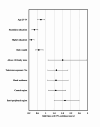Inadequacy of antenatal care attendance and its determinants amongst pregnant women in Ethiopia based on the 2019 Mini-Ethiopian demographic health survey: secondary data analysis
- PMID: 39425048
- PMCID: PMC11490034
- DOI: 10.1186/s12884-024-06884-3
Inadequacy of antenatal care attendance and its determinants amongst pregnant women in Ethiopia based on the 2019 Mini-Ethiopian demographic health survey: secondary data analysis
Abstract
Background: Inadequacy of antenatal care (ANC) utilization is a prominent public health problem, causing poor pregnancy outcomes. In developing countries, including Ethiopia, having ANC coverage, many pregnant women do not achieve the first ANC visits in the first trimester and receive at least four ANC visits. Therefore, this study aimed to examine the magnitude and identify determinants of inadequacy of antenatal care attendance amongst pregnant women in Ethiopia.
Methods: Inadequate ANC attendance was defined as combining starting ANC visits after the first trimester and having fewer than four visits together. The study used secondary data from the 2019 mini-demographic and health survey. A weighted sample of 3927 pregnant women was included in this study. Data management and further analysis were performed using STATA 14 software. A multivariable generalized estimating equation analysis was used to identify determinants associated with inadequacy of antenatal care attendance. The Adjusted odds ratio with a 95% confidence interval was used to identify significant variables for inadequate antenatal care visits.
Result: Overall, 78.5% of pregnant women did not attend adequate antenatal care visits during pregnancy. In multivariable generalized estimating equation analysis, women aged 25 to 34 years (AOR = 0.77, 95% CI: 0.61-0.95), being educated (AOR = 0.31; 95% CI: 0.22-0.45), and being wealthier index (AOR = 0.67, 95% CI: 0.51-0.88) were less likely to inadequate antenatal care attendance. Whereas being rural residents (AOR = 1.49; 95% CI:1.08-2.07), no television exposure (AOR = 1.51; 95% CI:1.1-2.06), having more family members in the household (AOR = 1.81; 95% CI: 1.11-2.95), and women from semi-peripheral region (AOR = 1.92; 95% CI: 1.42-2.59) were higher odds of being associated with inadequacy of antenatal care attendance.
Conclusions: The prevalence of Inadequate antenatal care attendance amongst pregnant women in Ethiopia is still High. The study identifies significant variables that could be positively and negatively associated with inadequate antenatal care visits. Health education interventions should target uneducated, poorer, and rural women to attend early antenatal care and use at least four antenatal care utilization for early detection of complications during pregnancy and delivery.
Keywords: Adequacy; Antenatal care visits; Ethiopia; Pregnant women.
© 2024. The Author(s).
Conflict of interest statement
The authors declare no competing interests.
Figures
Similar articles
-
Time to initiation of antenatal care and its predictors among pregnant women in Ethiopia: Cox-gamma shared frailty model.PLoS One. 2021 Feb 5;16(2):e0246349. doi: 10.1371/journal.pone.0246349. eCollection 2021. PLoS One. 2021. PMID: 33544714 Free PMC article.
-
Health system and community level interventions for improving antenatal care coverage and health outcomes.Cochrane Database Syst Rev. 2015 Dec 1;2015(12):CD010994. doi: 10.1002/14651858.CD010994.pub2. Cochrane Database Syst Rev. 2015. PMID: 26621223 Free PMC article.
-
Provision of recommended antenatal care services in Ethiopia: missed opportunity for screening and counselling.BMC Pregnancy Childbirth. 2025 May 8;25(1):543. doi: 10.1186/s12884-025-07684-z. BMC Pregnancy Childbirth. 2025. PMID: 40340703 Free PMC article.
-
Risk factors for puerperal sepsis among postpartum women attending public hospitals in the Dawro Zone, Southwest Ethiopia: Unmatched case‒control study.Womens Health (Lond). 2025 Jan-Dec;21:17455057251355366. doi: 10.1177/17455057251355366. Epub 2025 Jul 9. Womens Health (Lond). 2025. PMID: 40635378 Free PMC article.
-
Strategies of testing for syphilis during pregnancy.Cochrane Database Syst Rev. 2014 Oct 29;2014(10):CD010385. doi: 10.1002/14651858.CD010385.pub2. Cochrane Database Syst Rev. 2014. PMID: 25352226 Free PMC article.
Cited by
-
Utilization of maternal healthcare services in low- and middle-income countries: a systematic review and meta-analysis.Syst Rev. 2025 Apr 16;14(1):88. doi: 10.1186/s13643-025-02832-0. Syst Rev. 2025. PMID: 40241227 Free PMC article.
References
-
- WHO. WHO recommendations on antenatal care for a positive pregnancy experience. World Health Organization; 2016. - PubMed
-
- Habte A, Tamene A, Melis T. Compliance towards WHO recommendations on antenatal care for a positive pregnancy experience: timeliness and adequacy of antenatal care visit in sub-saharan African countries: evidence from the most recent standard Demographic Health Survey data. PLoS ONE. 2024;19(1):e0294981. - PMC - PubMed
-
- Ahmed I, Ali SM, Amenga-Etego S, Ariff S, Bahl R, Baqui AH, et al. Population-based rates, timing, and causes of maternal deaths, stillbirths, and neonatal deaths in south Asia and sub-saharan Africa: a multi-country prospective cohort study. Lancet Global Health. 2018;6(12):e1297–308. - PMC - PubMed
-
- Kalipeni E, Iwelunmor J, Grigsby-Toussaint D. Maternal and child health in Africa for sustainable development goals beyond 2015. Taylor & Francis; 2017. pp. 643–7. - PubMed
MeSH terms
LinkOut - more resources
Full Text Sources
Medical


